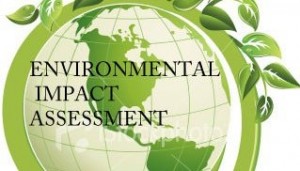In this blog post, Sunidhi, a student of the Rajiv Gandhi National University of Law, Patiala writes about Environment Impact Assessment (EIA). The blog post explains the procedure followed while granting EIA approval and also the limitations of EIA.
Environment Impact Assessment (EIA) is a significant measure to tackle the ever-increasing environmental issues. It is a tool to strike a balance between economic development and environment protection. Its aim is to ensure that all the resources are efficiently utilized keeping in mind the goal of sustainable development.
The main purpose of EIA is to scan all the risks and dangers associated either with a new project or with the renewal of an existing project. EIA is a detailed study of a development project either new or an existing one to analyze the amount of risk associated with it and the impact (positive and negative) that it will have on the environment. It is a very useful tool to analyze the impact of the developmental project and then to decide by social, economic, cultural and other concerns which can be consolidated with cost and benefit analysis. Ideally, it should be conducted at the planning stage so as to opt for the least environment harming techniques, the most environmentally viable site and other necessary protective measures to reduce the negative impact of the project.
Environment clearance
The Government of India and the Union Ministry of Environment and Forests (MEF), issued an EIA Notification of 1994 making Environmental Clearance (EC) mandatory under the Environmental (Protection) Act 1986, either for expansion or modernization of any activity or for setting up new projects listed in Schedule 1 of the notification. Now, the Notification of 1994 has been replaced by the Notification of 2006.
As per the notification issued, all new projects/activities and expansion or modernization of the projects notified in Schedule to the notification require prior EIA approval. Also, a set limit of investment is also fixed for projects required to undergo EIA.
An application has to be submitted for prior environment clearance (as prescribed in Form I). Once the application is submitted, the following procedure is carried on:
- If the application is for Category B, then it is screened for whether it requires EIA approval or not but in the case of Category A EIA. Then it is compulsory.
- After scrutinizing all the applications, the Expert Appraisal Committee collects all data and information relating to the project. It then analyses the impact and gives alternate options, if any. Also, an Environment Impact Assessment (EIA) Report is prepared.
- After collecting the required data, a public hearing is conducted, and the issues of all the stakeholders are heard. Stakeholders include general public residing near the development project site and all others who have some interest in the project.
- After this, all the technicalities are considered by the expert committee, and the final decision is given whether the project is approved or not. In case approval is given, a certificate is issued. In case plan is rejected then the procedure ends there.
- The monitoring continues even after the development of the project. And the project developers are to submit a report about the working conditions after every six months.
Ineffectiveness of EIA
The EIA of India is not as effective as it could have been if a separate legislation would have been passed in India. The Bhopal catastrophe discloses the malady of a legal system that failed to stress on the mandatory need for an open EIA. There are 2 EIA models: mandatory and discretionary model. The former makes it compulsory to conduct public hearing whereas it is not necessary to conduct a public hearing in the case of latter.
Bhopal is a victim of discretionary model of EIA. When a license was applied for, and the carbide plant was about to start operations, many factors seem to have been overlooked or ignored- there were bungalows near the site, a housing estate was being built close by, and the Bhopal railway station, the centre of hectic commercial and trading activities, was only 3 kilometers away. It was alleged that approval was given to a plant, whose design was defective from the standpoint of safety and that Canada had reportedly rejected a project of identical design. Moreover, there were reports of several accidents. The dark side of a discretionary model was revealed after this disaster.
There are many more such cases revealing the shortcomings of EIA conducted in India. Also, the reports are published in English, the language which half of the Indians do not understand. Therefore, the local people fail to understand their rights and obligations. Hence, the public hearings are not that effective as they could have been if a proper law was implemented. The officers appointed in Pollution Controls Boards may not be experts always as these posts are politicized to secure more and more votes and funds from big business houses for an election campaign.
These incidents highlight that there is an urgent need for making changes in the present legal system governing EIA and implementation of stricter laws.
Judicial response
The Judiciary has played a very effective role in filling the yawning gaps in the environmental laws in India. In Sterlite Industries (India) Ltd. v. The Union of India, the Supreme Court enlightened the grounds on which EIA approval can be challenged. The grounds are procedural impropriety, illegality, and irrationality. If the approval is given without following the due procedure of law, then it can be challenged on the ground of procedural impropriety. If the approval is given by anyone other than the competent authority, then it can be challenged on the ground of illegality. And the last ground of rationality can be invoked if the decision suffers from extreme unreasonableness (Wednesbury Principle). Similarly, in many other cases, Judiciary has done appreciable work.
Hence, it has tried to strike a balance between development and environment protection.
Suggestions
EIA is still in nascent stages. A separate legislation may be enacted on the lines of the U.S. National Environmental Policy Act of 1969, which could provide EIA a statutory requirement for all polluting activities or proposed development plans.
The entire process should not be done in a state of secrecy but be amenable to public scrutiny and review by judicial bodies. EIA needs to be institutionalized and standardized and public participation by involving NGOs be made mandatory so as to ensure administratively and public acceptability of anticipatory activities in the project.
EIA is a tool which if effectively used can bring revolution in the environment law. Hence, it should be properly implemented.














